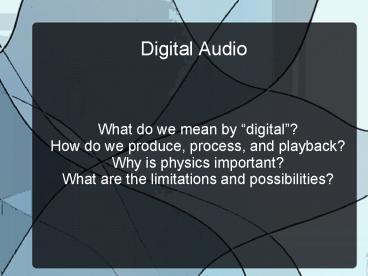Digital Audio - PowerPoint PPT Presentation
Title:
Digital Audio
Description:
Digital Audio What do we mean by digital ? How do we produce, process, and playback? Why is physics important? What are the limitations and possibilities? – PowerPoint PPT presentation
Number of Views:189
Avg rating:3.0/5.0
Title: Digital Audio
1
Digital Audio
- What do we mean by digital?
- How do we produce, process, and playback?
- Why is physics important?
- What are the limitations and possibilities?
2
Digital vs. Analog
- Discrete data
- Reproducible with 100 fidelity
- Can be stored using any digital medium
- Frequency and amplitude ranges limited by
digitization
- Continuous data
- Reproduction introduces new noise
- Storage limited by physical size
- Virtually unlimited frequency and amplitude ranges
3
Physics of Digitization
- Sound (pressure wave) is transduced into an
electrical signal (usually voltage) - Signal read by A-D converter to discrete values
- Time sequence of signal values encoded in a
computer
4
Sampling Basics
- Sample Rate Frequency interval of the time
sequence of encoded values - Sample Depth (or Bit Depth) Number of bits used
to encode each value - Bit Rate (Sample Rate) x (Bit Depth)
- For example, CD Quality audio is 44.1kHz at 16
bits 7.065E5 bps per channel, or 1411 kbps total
5
Sample Rate (Sample Frequency)
- Sample Period 0.5s
- Sample Rate 1/0.5s 2Hz
6
Sample Rate Matters!(Mathematica Demo 1)
7
What do the samples actually represent?
8
Nyquist-Shannon Sampling Theorem
- If a function x(t) contains no frequencies
higher than B, it is completely determined by
giving its ordinates at a series of points spaced
1/(2B) seconds apart. - A necessary condition for digitizing a signal so
that it can be faithfully reconstructed is that
the sample rate is at least twice as high as the
highest frequency present in the signal.
9
What can go wrong?
- Aliasing High frequencies contribute signal
components that are perceived as lower
frequencies (Mathematica Demo 2)
10
Bit Depth
- Number of bits used to represent each sampled
value - Available discrete values n2b
- Here there are only 5 discrete values, so 3 bits
per sample
11
Dynamic Range
- Ability to represent small and large amplitude
signals in the same scheme - Clipping Large signals are cut off, introducing
high harmonics - Masking Small signals are drowned out
12
Signal-to-Noise Ratio (S/N)
- Ratio of meaningful signal power to unwanted
signal power - In sound, the audible power (decibels) is
skewed from the actual power - Best case scenario noise is in the first bit
- S/N (dB) 10 Log (2b) 3.01b (per channel)
- Human ear sensitivity covers a range of more than
120dB! (40 bits)
13
Digital Audio Compression
- Analog signals are practically incompressible
- Raw audio signals are similarly hard to reduce
using standard (lossless) file compression
(Shannon Information Theory) - Psycho-acoustic models may be helpful! (lossy)
14
MP3 Codec
- Divide the file into packets and find the Fourier
power spectrum via DFT - Throw out easily masked frequencies to reach
desired bit rate - Dither regions with different dynamic ranges or
where the bit depth must be lowered to match
desired bit rate - Perform traditional redundancy compression
- (ratatat samples)
15
Discrete Fourier Transform
- Frequency Limit ½ Sample Frequency (Nyquist)
- Frequency Resolution 1/Signal Period
(Mathematica 3) - Usually frequency resolution is much sharper than
the ear can detect
16
Dithering
17
Digital Signal Processing (DSP)
- Non-linear (ie, atemporal)
- Real-time effects subject to latency and
buffering memory - Filters and envelopes extremely
difficult/expensive to achieve with analog
techniques - Easier non-destructive editing
- Perfect fidelity in copying
18
Some Common DSP Effects
- Vocoder vs Autotune (Daft Punk)
- Delay/Echo (U2, David Gray)
- Filter/Flange (Foster the People, Dizzy Gillespie)
19
Digital Synthesis (If you can write an equation,
you can hear it!)
- Sound engineering for movies/TV
- Arbitrary mathematical functions can be generated
(Mathematica 4) - Sounds not identifiable by the ear/brain
- (Chem Bros and Skrillex samples)































